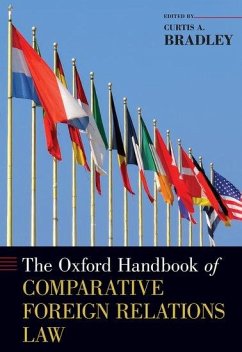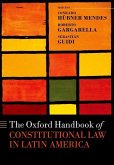The Oxford Handbook of Comparative Foreign Relations Law
Herausgeber: Bradley, Curtis A
The Oxford Handbook of Comparative Foreign Relations Law
Herausgeber: Bradley, Curtis A
- Gebundenes Buch
- Merkliste
- Auf die Merkliste
- Bewerten Bewerten
- Teilen
- Produkt teilen
- Produkterinnerung
- Produkterinnerung
This 46-chapter book, written by leading experts across the globe, compares and contrasts the foreign relations law of nations around the world, both documenting important differences and also noting commonalities and emerging trends. Comparative foreign relations law is a newly emerging field of study and teaching, and this volume is likely to become a key reference work as the field continues to develop.
Andere Kunden interessierten sich auch für
![The Oxford Handbook of Comparative Judicial Behaviour The Oxford Handbook of Comparative Judicial Behaviour]() Lee EpsteinThe Oxford Handbook of Comparative Judicial Behaviour273,99 €
Lee EpsteinThe Oxford Handbook of Comparative Judicial Behaviour273,99 €![The Oxford Handbook of Jurisdiction in International Law The Oxford Handbook of Jurisdiction in International Law]() The Oxford Handbook of Jurisdiction in International Law219,99 €
The Oxford Handbook of Jurisdiction in International Law219,99 €![The Oxford Handbook of Law and Anthropology The Oxford Handbook of Law and Anthropology]() The Oxford Handbook of Law and Anthropology244,99 €
The Oxford Handbook of Law and Anthropology244,99 €![The Oxford Handbook of the Law of Work The Oxford Handbook of the Law of Work]() Guy DavidovThe Oxford Handbook of the Law of Work226,99 €
Guy DavidovThe Oxford Handbook of the Law of Work226,99 €![The Oxford Handbook of International Criminal Law The Oxford Handbook of International Criminal Law]() Darryl RobinsonThe Oxford Handbook of International Criminal Law255,99 €
Darryl RobinsonThe Oxford Handbook of International Criminal Law255,99 €![The Oxford Handbook of Comparative Health Law The Oxford Handbook of Comparative Health Law]() The Oxford Handbook of Comparative Health Law297,99 €
The Oxford Handbook of Comparative Health Law297,99 €![The Oxford Handbook of Constitutional Law in Latin America The Oxford Handbook of Constitutional Law in Latin America]() The Oxford Handbook of Constitutional Law in Latin America257,99 €
The Oxford Handbook of Constitutional Law in Latin America257,99 €-
-
-
This 46-chapter book, written by leading experts across the globe, compares and contrasts the foreign relations law of nations around the world, both documenting important differences and also noting commonalities and emerging trends. Comparative foreign relations law is a newly emerging field of study and teaching, and this volume is likely to become a key reference work as the field continues to develop.
Hinweis: Dieser Artikel kann nur an eine deutsche Lieferadresse ausgeliefert werden.
Hinweis: Dieser Artikel kann nur an eine deutsche Lieferadresse ausgeliefert werden.
Produktdetails
- Produktdetails
- Verlag: Oxford University Press
- Seitenzahl: 896
- Erscheinungstermin: 8. Juli 2019
- Englisch
- Abmessung: 256mm x 187mm x 60mm
- Gewicht: 1671g
- ISBN-13: 9780190653330
- ISBN-10: 0190653337
- Artikelnr.: 55313739
- Herstellerkennzeichnung
- Libri GmbH
- Europaallee 1
- 36244 Bad Hersfeld
- gpsr@libri.de
- Verlag: Oxford University Press
- Seitenzahl: 896
- Erscheinungstermin: 8. Juli 2019
- Englisch
- Abmessung: 256mm x 187mm x 60mm
- Gewicht: 1671g
- ISBN-13: 9780190653330
- ISBN-10: 0190653337
- Artikelnr.: 55313739
- Herstellerkennzeichnung
- Libri GmbH
- Europaallee 1
- 36244 Bad Hersfeld
- gpsr@libri.de
Curtis A. Bradley is the William Van Alstyne Professor of Law at Duke Law School, where he is a co-director of the Law School's Center for International and Comparative Law.
* Preface Curtis A. Bradley
* Notes on the Contributors
* Part I: Comparative Foreign Relations Law as a Field
* Chapter 1: Curtis A. Bradley, What is Foreign Relations Law?
* Chapter 2: Campbell McLachlan, Five Conceptions of the Function of
Foreign Relations Law
* Chapter 3: Karen Knop, Foreign Relations Law: Comparison as Invention
* Chapter 4: Tom Ginsburg, Comparative Foreign Relations Law:
* A National Constitutions Perspective
* Chapter 5: Oona A. Hathaway, A Comparative Foreign Relations Law
Agenda:
* Opportunities and Challenges
* Chapter 6: Jenny S. Martinez, The Constitutional Allocation of
Executive and
* Legislative Power Over Foreign Affairs: A Survey
* Chapter 7: Alejandro Rodiles, Executive Power in Foreign Affairs: The
Case for
* Inventing a Mexican Foreign Relations Law
* Part II. Making Treaties and Other International Agreements
* Chapter 8: Pierre-Hugues Verdier and Mila Versteeg, Separation of
Powers,
* Treaty-Making, and Treaty Withdrawal: A Global Survey
* Chapter 9: Jean Galbraith, International Agreements and U.S. Foreign
Relations Law:
* Complexity in Action
* Chapter 10: Stefan Kadelbach, International Treaties and the German
Constitution
* Chapter 11: Tadaatsu Mori, The Current Practice of Making and
Applying International
* Agreements in Japan
* Chapter 12: Carlos Esposito, Spanish Foreign Relations Law and the
Process for
* Making Treaties and Other International Agreements
* Chapter 13: Jaemin Lee, Incorporation and Implementation of Treaties
in South Korea
* Chapter 14: Marise Cremona, Making Treaties and Other International
Agreements:
* The European Union
* Part III. Federalism and Foreign Affairs
* Chapter 15: Ernest A. Young, Foreign Affairs Federalism in the United
States
* Chapter 16: Charles-Emmanuel Côté, Federalism and Foreign Affairs in
Canada
* Chapter 17: Roland Portmann, Foreign Affairs Federalism in
Switzerland
* Chapter 18: Anamika Asthana and Happymon Jacob, Federalism and
Foreign Affairs in India
* Chapter 19: Robert Schütze, Foreign Affairs Federalism in the
European Union
* Part IV. Engaging With, and Disengaging From, International
Institutions
* Chapter 20: Laurence R. Helfer, Treaty Exit and Intra-Branch Conflict
at the Interface of
* International and Domestic Law
* Chapter 21: Paul B. Stephan, Constitutionalism and Internationalism:
U.S Participation in
* International Institutions
* Chapter 22: Paul Craig, Engagement and Disengagement with
International Institutions:
* The UK Perspective
* Chapter 23: Andreas L. Paulus and Jan-Henrik Hinselmann,
"International Integration and Its
* Counter-Limits: A German Constitutional Perspective"
* Chapter 24: Hannah Woolaver, State Engagement with Treaties:
Interactions Between International and Domestic Law
* Chapter 25: Joris Larik, Regional Organizations' Relations with
International Institutions:
* The EU and ASEAN Compared
* Part V. Domestic Application of International Law
* Chapter 26: Duncan B. Hollis and Carlos M. Vázquez, Treaty
Self-Execution as
* "Foreign" Foreign Relations Law
* Chapter 27: Shaheed Fatima, The Domestic Application of International
Law in
* British Courts
* Chapter 28: Gib Van Ert, The Domestic Application of International
Law in Canada
* Chapter 29: Amichai Cohen, International Law in Israeli Courts
* Chapter 30: Hiromichi Matsuda, International Law in Japanese Courts
* Chapter 31: Congyan Cai, International Law in Chinese Courts
* Chapter 32: Rene Urueña, Domestic Application of International Law in
Latin America
* Chapter 33: Ernest Yaw Ako and Richard Frimpong Oppong, Foreign
Relations Law
* in the Constitutions and Courts of Commonwealth African Countries
* Chapter 34: Mario Mendez, The Application of International Law by the
Court of Justice
* of the European Union
* Part VI. Immunity, Comity, and Related Issues
* Chapter 35: David P. Stewart, International Immunities in U.S. Law
* Chapter 36: Philippa Webb, International Immunities in English Law
* Chapter 37: Hennie Strydom, South African Law on Immunities
* Chapter 38: Andrea Bianchi, Jurisdictional Immunities, Constitutional
Values,
* and System Closures
* Chapter 39: William S. Dodge, International Comity in Comparative
Perspective
* Chapter 40: Eirik Bjorge and Cameron Miles, Crown and Foreign Acts of
State
* Before British Courts: Ramatullah, Belhaj, and the Separation of
Powers
* Part VII: The Use of Military Force
* Chapter 41: Monica Hakimi, Techniques for Regulating Military Force
* Chaper 42: Curtis A. Bradley, U.S. War Powers and the Potential
Benefits of Comparativism
* Chaper 43: Katja S. Ziegler, The Use of Force by the United Kingdom:
The Evolution of
* Accountability
* Chapter 44: Anne Peters, Military Operations Abroad Under the German
Basic Law
* Chaper 45: Mathias Forteau, Using Military Force and Engaging in
Collective Security:
* The Case of France
* Chapter 46: Tadashi Mori, Decisions in Japan to Use Military Force or
to Participate in
* Multinational Peacekeeping Operations
* Notes on the Contributors
* Part I: Comparative Foreign Relations Law as a Field
* Chapter 1: Curtis A. Bradley, What is Foreign Relations Law?
* Chapter 2: Campbell McLachlan, Five Conceptions of the Function of
Foreign Relations Law
* Chapter 3: Karen Knop, Foreign Relations Law: Comparison as Invention
* Chapter 4: Tom Ginsburg, Comparative Foreign Relations Law:
* A National Constitutions Perspective
* Chapter 5: Oona A. Hathaway, A Comparative Foreign Relations Law
Agenda:
* Opportunities and Challenges
* Chapter 6: Jenny S. Martinez, The Constitutional Allocation of
Executive and
* Legislative Power Over Foreign Affairs: A Survey
* Chapter 7: Alejandro Rodiles, Executive Power in Foreign Affairs: The
Case for
* Inventing a Mexican Foreign Relations Law
* Part II. Making Treaties and Other International Agreements
* Chapter 8: Pierre-Hugues Verdier and Mila Versteeg, Separation of
Powers,
* Treaty-Making, and Treaty Withdrawal: A Global Survey
* Chapter 9: Jean Galbraith, International Agreements and U.S. Foreign
Relations Law:
* Complexity in Action
* Chapter 10: Stefan Kadelbach, International Treaties and the German
Constitution
* Chapter 11: Tadaatsu Mori, The Current Practice of Making and
Applying International
* Agreements in Japan
* Chapter 12: Carlos Esposito, Spanish Foreign Relations Law and the
Process for
* Making Treaties and Other International Agreements
* Chapter 13: Jaemin Lee, Incorporation and Implementation of Treaties
in South Korea
* Chapter 14: Marise Cremona, Making Treaties and Other International
Agreements:
* The European Union
* Part III. Federalism and Foreign Affairs
* Chapter 15: Ernest A. Young, Foreign Affairs Federalism in the United
States
* Chapter 16: Charles-Emmanuel Côté, Federalism and Foreign Affairs in
Canada
* Chapter 17: Roland Portmann, Foreign Affairs Federalism in
Switzerland
* Chapter 18: Anamika Asthana and Happymon Jacob, Federalism and
Foreign Affairs in India
* Chapter 19: Robert Schütze, Foreign Affairs Federalism in the
European Union
* Part IV. Engaging With, and Disengaging From, International
Institutions
* Chapter 20: Laurence R. Helfer, Treaty Exit and Intra-Branch Conflict
at the Interface of
* International and Domestic Law
* Chapter 21: Paul B. Stephan, Constitutionalism and Internationalism:
U.S Participation in
* International Institutions
* Chapter 22: Paul Craig, Engagement and Disengagement with
International Institutions:
* The UK Perspective
* Chapter 23: Andreas L. Paulus and Jan-Henrik Hinselmann,
"International Integration and Its
* Counter-Limits: A German Constitutional Perspective"
* Chapter 24: Hannah Woolaver, State Engagement with Treaties:
Interactions Between International and Domestic Law
* Chapter 25: Joris Larik, Regional Organizations' Relations with
International Institutions:
* The EU and ASEAN Compared
* Part V. Domestic Application of International Law
* Chapter 26: Duncan B. Hollis and Carlos M. Vázquez, Treaty
Self-Execution as
* "Foreign" Foreign Relations Law
* Chapter 27: Shaheed Fatima, The Domestic Application of International
Law in
* British Courts
* Chapter 28: Gib Van Ert, The Domestic Application of International
Law in Canada
* Chapter 29: Amichai Cohen, International Law in Israeli Courts
* Chapter 30: Hiromichi Matsuda, International Law in Japanese Courts
* Chapter 31: Congyan Cai, International Law in Chinese Courts
* Chapter 32: Rene Urueña, Domestic Application of International Law in
Latin America
* Chapter 33: Ernest Yaw Ako and Richard Frimpong Oppong, Foreign
Relations Law
* in the Constitutions and Courts of Commonwealth African Countries
* Chapter 34: Mario Mendez, The Application of International Law by the
Court of Justice
* of the European Union
* Part VI. Immunity, Comity, and Related Issues
* Chapter 35: David P. Stewart, International Immunities in U.S. Law
* Chapter 36: Philippa Webb, International Immunities in English Law
* Chapter 37: Hennie Strydom, South African Law on Immunities
* Chapter 38: Andrea Bianchi, Jurisdictional Immunities, Constitutional
Values,
* and System Closures
* Chapter 39: William S. Dodge, International Comity in Comparative
Perspective
* Chapter 40: Eirik Bjorge and Cameron Miles, Crown and Foreign Acts of
State
* Before British Courts: Ramatullah, Belhaj, and the Separation of
Powers
* Part VII: The Use of Military Force
* Chapter 41: Monica Hakimi, Techniques for Regulating Military Force
* Chaper 42: Curtis A. Bradley, U.S. War Powers and the Potential
Benefits of Comparativism
* Chaper 43: Katja S. Ziegler, The Use of Force by the United Kingdom:
The Evolution of
* Accountability
* Chapter 44: Anne Peters, Military Operations Abroad Under the German
Basic Law
* Chaper 45: Mathias Forteau, Using Military Force and Engaging in
Collective Security:
* The Case of France
* Chapter 46: Tadashi Mori, Decisions in Japan to Use Military Force or
to Participate in
* Multinational Peacekeeping Operations
* Preface Curtis A. Bradley
* Notes on the Contributors
* Part I: Comparative Foreign Relations Law as a Field
* Chapter 1: Curtis A. Bradley, What is Foreign Relations Law?
* Chapter 2: Campbell McLachlan, Five Conceptions of the Function of
Foreign Relations Law
* Chapter 3: Karen Knop, Foreign Relations Law: Comparison as Invention
* Chapter 4: Tom Ginsburg, Comparative Foreign Relations Law:
* A National Constitutions Perspective
* Chapter 5: Oona A. Hathaway, A Comparative Foreign Relations Law
Agenda:
* Opportunities and Challenges
* Chapter 6: Jenny S. Martinez, The Constitutional Allocation of
Executive and
* Legislative Power Over Foreign Affairs: A Survey
* Chapter 7: Alejandro Rodiles, Executive Power in Foreign Affairs: The
Case for
* Inventing a Mexican Foreign Relations Law
* Part II. Making Treaties and Other International Agreements
* Chapter 8: Pierre-Hugues Verdier and Mila Versteeg, Separation of
Powers,
* Treaty-Making, and Treaty Withdrawal: A Global Survey
* Chapter 9: Jean Galbraith, International Agreements and U.S. Foreign
Relations Law:
* Complexity in Action
* Chapter 10: Stefan Kadelbach, International Treaties and the German
Constitution
* Chapter 11: Tadaatsu Mori, The Current Practice of Making and
Applying International
* Agreements in Japan
* Chapter 12: Carlos Esposito, Spanish Foreign Relations Law and the
Process for
* Making Treaties and Other International Agreements
* Chapter 13: Jaemin Lee, Incorporation and Implementation of Treaties
in South Korea
* Chapter 14: Marise Cremona, Making Treaties and Other International
Agreements:
* The European Union
* Part III. Federalism and Foreign Affairs
* Chapter 15: Ernest A. Young, Foreign Affairs Federalism in the United
States
* Chapter 16: Charles-Emmanuel Côté, Federalism and Foreign Affairs in
Canada
* Chapter 17: Roland Portmann, Foreign Affairs Federalism in
Switzerland
* Chapter 18: Anamika Asthana and Happymon Jacob, Federalism and
Foreign Affairs in India
* Chapter 19: Robert Schütze, Foreign Affairs Federalism in the
European Union
* Part IV. Engaging With, and Disengaging From, International
Institutions
* Chapter 20: Laurence R. Helfer, Treaty Exit and Intra-Branch Conflict
at the Interface of
* International and Domestic Law
* Chapter 21: Paul B. Stephan, Constitutionalism and Internationalism:
U.S Participation in
* International Institutions
* Chapter 22: Paul Craig, Engagement and Disengagement with
International Institutions:
* The UK Perspective
* Chapter 23: Andreas L. Paulus and Jan-Henrik Hinselmann,
"International Integration and Its
* Counter-Limits: A German Constitutional Perspective"
* Chapter 24: Hannah Woolaver, State Engagement with Treaties:
Interactions Between International and Domestic Law
* Chapter 25: Joris Larik, Regional Organizations' Relations with
International Institutions:
* The EU and ASEAN Compared
* Part V. Domestic Application of International Law
* Chapter 26: Duncan B. Hollis and Carlos M. Vázquez, Treaty
Self-Execution as
* "Foreign" Foreign Relations Law
* Chapter 27: Shaheed Fatima, The Domestic Application of International
Law in
* British Courts
* Chapter 28: Gib Van Ert, The Domestic Application of International
Law in Canada
* Chapter 29: Amichai Cohen, International Law in Israeli Courts
* Chapter 30: Hiromichi Matsuda, International Law in Japanese Courts
* Chapter 31: Congyan Cai, International Law in Chinese Courts
* Chapter 32: Rene Urueña, Domestic Application of International Law in
Latin America
* Chapter 33: Ernest Yaw Ako and Richard Frimpong Oppong, Foreign
Relations Law
* in the Constitutions and Courts of Commonwealth African Countries
* Chapter 34: Mario Mendez, The Application of International Law by the
Court of Justice
* of the European Union
* Part VI. Immunity, Comity, and Related Issues
* Chapter 35: David P. Stewart, International Immunities in U.S. Law
* Chapter 36: Philippa Webb, International Immunities in English Law
* Chapter 37: Hennie Strydom, South African Law on Immunities
* Chapter 38: Andrea Bianchi, Jurisdictional Immunities, Constitutional
Values,
* and System Closures
* Chapter 39: William S. Dodge, International Comity in Comparative
Perspective
* Chapter 40: Eirik Bjorge and Cameron Miles, Crown and Foreign Acts of
State
* Before British Courts: Ramatullah, Belhaj, and the Separation of
Powers
* Part VII: The Use of Military Force
* Chapter 41: Monica Hakimi, Techniques for Regulating Military Force
* Chaper 42: Curtis A. Bradley, U.S. War Powers and the Potential
Benefits of Comparativism
* Chaper 43: Katja S. Ziegler, The Use of Force by the United Kingdom:
The Evolution of
* Accountability
* Chapter 44: Anne Peters, Military Operations Abroad Under the German
Basic Law
* Chaper 45: Mathias Forteau, Using Military Force and Engaging in
Collective Security:
* The Case of France
* Chapter 46: Tadashi Mori, Decisions in Japan to Use Military Force or
to Participate in
* Multinational Peacekeeping Operations
* Notes on the Contributors
* Part I: Comparative Foreign Relations Law as a Field
* Chapter 1: Curtis A. Bradley, What is Foreign Relations Law?
* Chapter 2: Campbell McLachlan, Five Conceptions of the Function of
Foreign Relations Law
* Chapter 3: Karen Knop, Foreign Relations Law: Comparison as Invention
* Chapter 4: Tom Ginsburg, Comparative Foreign Relations Law:
* A National Constitutions Perspective
* Chapter 5: Oona A. Hathaway, A Comparative Foreign Relations Law
Agenda:
* Opportunities and Challenges
* Chapter 6: Jenny S. Martinez, The Constitutional Allocation of
Executive and
* Legislative Power Over Foreign Affairs: A Survey
* Chapter 7: Alejandro Rodiles, Executive Power in Foreign Affairs: The
Case for
* Inventing a Mexican Foreign Relations Law
* Part II. Making Treaties and Other International Agreements
* Chapter 8: Pierre-Hugues Verdier and Mila Versteeg, Separation of
Powers,
* Treaty-Making, and Treaty Withdrawal: A Global Survey
* Chapter 9: Jean Galbraith, International Agreements and U.S. Foreign
Relations Law:
* Complexity in Action
* Chapter 10: Stefan Kadelbach, International Treaties and the German
Constitution
* Chapter 11: Tadaatsu Mori, The Current Practice of Making and
Applying International
* Agreements in Japan
* Chapter 12: Carlos Esposito, Spanish Foreign Relations Law and the
Process for
* Making Treaties and Other International Agreements
* Chapter 13: Jaemin Lee, Incorporation and Implementation of Treaties
in South Korea
* Chapter 14: Marise Cremona, Making Treaties and Other International
Agreements:
* The European Union
* Part III. Federalism and Foreign Affairs
* Chapter 15: Ernest A. Young, Foreign Affairs Federalism in the United
States
* Chapter 16: Charles-Emmanuel Côté, Federalism and Foreign Affairs in
Canada
* Chapter 17: Roland Portmann, Foreign Affairs Federalism in
Switzerland
* Chapter 18: Anamika Asthana and Happymon Jacob, Federalism and
Foreign Affairs in India
* Chapter 19: Robert Schütze, Foreign Affairs Federalism in the
European Union
* Part IV. Engaging With, and Disengaging From, International
Institutions
* Chapter 20: Laurence R. Helfer, Treaty Exit and Intra-Branch Conflict
at the Interface of
* International and Domestic Law
* Chapter 21: Paul B. Stephan, Constitutionalism and Internationalism:
U.S Participation in
* International Institutions
* Chapter 22: Paul Craig, Engagement and Disengagement with
International Institutions:
* The UK Perspective
* Chapter 23: Andreas L. Paulus and Jan-Henrik Hinselmann,
"International Integration and Its
* Counter-Limits: A German Constitutional Perspective"
* Chapter 24: Hannah Woolaver, State Engagement with Treaties:
Interactions Between International and Domestic Law
* Chapter 25: Joris Larik, Regional Organizations' Relations with
International Institutions:
* The EU and ASEAN Compared
* Part V. Domestic Application of International Law
* Chapter 26: Duncan B. Hollis and Carlos M. Vázquez, Treaty
Self-Execution as
* "Foreign" Foreign Relations Law
* Chapter 27: Shaheed Fatima, The Domestic Application of International
Law in
* British Courts
* Chapter 28: Gib Van Ert, The Domestic Application of International
Law in Canada
* Chapter 29: Amichai Cohen, International Law in Israeli Courts
* Chapter 30: Hiromichi Matsuda, International Law in Japanese Courts
* Chapter 31: Congyan Cai, International Law in Chinese Courts
* Chapter 32: Rene Urueña, Domestic Application of International Law in
Latin America
* Chapter 33: Ernest Yaw Ako and Richard Frimpong Oppong, Foreign
Relations Law
* in the Constitutions and Courts of Commonwealth African Countries
* Chapter 34: Mario Mendez, The Application of International Law by the
Court of Justice
* of the European Union
* Part VI. Immunity, Comity, and Related Issues
* Chapter 35: David P. Stewart, International Immunities in U.S. Law
* Chapter 36: Philippa Webb, International Immunities in English Law
* Chapter 37: Hennie Strydom, South African Law on Immunities
* Chapter 38: Andrea Bianchi, Jurisdictional Immunities, Constitutional
Values,
* and System Closures
* Chapter 39: William S. Dodge, International Comity in Comparative
Perspective
* Chapter 40: Eirik Bjorge and Cameron Miles, Crown and Foreign Acts of
State
* Before British Courts: Ramatullah, Belhaj, and the Separation of
Powers
* Part VII: The Use of Military Force
* Chapter 41: Monica Hakimi, Techniques for Regulating Military Force
* Chaper 42: Curtis A. Bradley, U.S. War Powers and the Potential
Benefits of Comparativism
* Chaper 43: Katja S. Ziegler, The Use of Force by the United Kingdom:
The Evolution of
* Accountability
* Chapter 44: Anne Peters, Military Operations Abroad Under the German
Basic Law
* Chaper 45: Mathias Forteau, Using Military Force and Engaging in
Collective Security:
* The Case of France
* Chapter 46: Tadashi Mori, Decisions in Japan to Use Military Force or
to Participate in
* Multinational Peacekeeping Operations








